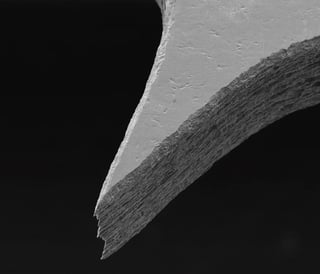Chemical Etching or Electroforming: which method suits your goals?
Jun 21, 2016 12:13:32 PM By Harrie KnolAs an engineer, your goal is to accelerate growth of your company through the innovation-driving technical solutions of tomorrow. In the Micro world nowadays, metal parts need to meet the increasing demands of precision. But before we are able to turn our ideas into complex precision metal parts, we must consider the best technology to apply. What are those considerations to choose a manufacturing method to meet all your needs?
In this article, we compare chemical etching to electroforming by analyzing some of the most important features such as precision, shape/hole geometry, materials, hardness and of course price.
Manufacturing methods can be separated into additive and subtractive methods. Electroforming is an additive process, whereas chemical etching is a subtractive process. When looking from a designing/sampling perspective, both chemical etching and electroforming are known to be fast, efficient, and cost effective. Both technologies deliver high precision, burr and stress free precision metal parts.
It becomes truly interesting when we highlight the features to take into consideration when choosing between additive (electroforming) and subtractive (chemical etching) production methods.
Precision
Needless to say, size is important. And when we say micro, we mean micron! Both technologies meet tight tolerances. What are we looking at when we express the standard deviation of the material thickness in percentages?
In electroforming, experts claim to deviate less than 1 μm (= 0,001 mm) of the materials thickness. The rule of thumb most people stick to is +/- 5% of the thickness of the material. Tolerances quoted on etched features will typically be +/- 10%. So when a part of 200 μm is chemically etched, the deviation might be 20 μm (0,02 mm).
Shape / hole geometry
In some industries, shape/hole geometry plays a significant role when considering different technologies.
In electroforming, two methods can be applied to control thickness and shape: electroforming overgrowth and electroforming thick resist. The unique shape resulting from the overgrowth method proves it's a method one can simply not realize with other techniques. Electroforming therefore lends itself for complex features and special shapes
The chemical etching process doesn't allow for control of the hole shape like electroforming does. However - when round holes, sharp edges and straight or profiled edges are desired, chemical etching is just as highly recommendable as electroforming.
Material (and hardness)
Choice of material is also an important factor when selecting the right manufacturing method.
In electroforming, nickel is predominantly used, followed by palladium nickel or copper. On the other hand, virtually all metals can be chemically etched with no restriction in hardness of the material.
However (!), the properties, in particular hardness, of nickel can be controlled in electroforming. Nickel has a controlled hardness of 200 to 670 HV (Vickers). You may not want to pinpoint on a material (such as stainless steel) but rather on the flexibility in properties of the material. This might open new doors in truly picking the right technology to create your metal parts.
Chemical etching might be a more suitable solution when material is predetermined and nickel is not the choice.

Fig. 1 chemical-etched feature Fig. 2 Electroformed feature
Conclusion: chemical etching or electroforming?
There is one aspect we haven't discussed yet in the choice between chemical etching and electroforming. That is: which technology is most attractive looking from a price perspective?
Generally, rule of thumb is; the higher the precision, the higher the price. So when tolerances are less important, the material is predetermined and the manufacturing costs of this material forms a boundary condition (price aspect), chemical etching wins the race. When micron precision and hole geometry/shape and high repeatability are the main consideration factors, electroforming is definitely your go-to technology.
Don't hesitate to ask one of our engineers for personal advice on your specific challenges!


